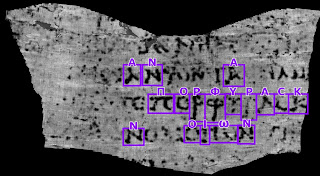 |
| One rather battered scroll; an introduction to the enormity of the Herculaneum research task |
 |
| Ink Detection in research |
The
first word to be read from an unopened scroll was found separately by both Luke Farritor and Youssef Nader — a computer science student at the University of Nebraska
and a graduate student in bio-robotics at Freie University, Berlin, respectively
— in October 2024. This year, joined by Julian Schilliger, a robotics student at ETH
Zürich, the three have won the Victoria Challenge’s $700,000 grand prize for being the
first team to decipher more than 85% of characters from four continuous
passages within the same scroll.
The trio uncovered the text by applying a technique known as “virtual unwrapping” to the rolled-up scroll — one of several owned by the Institut de France — which was released on the website. The process involved using computer tomography, *** an X-ray procedure to scan the coiled-up, warped papyrus, allowing the researchers to virtually flatten the scrolls and detect the ink on the page through advanced AI. They developed machine-learning algorithms to successfully detect and decipher the first complete passages of texts from scans of the charred scrolls. Seales said that there are grains of sand sprinkled all the way through the scrolls; "You can see them twinkling in the scans and that constellation is fixed." Using the sand grains like guide stars, the finished software should be able to orient the letters on more of the curled pages and line up multiple scans to verify the imagery.
 |
| After the virtual unwrapping some of the Herculaneum library was disclosed. |
When the trio of research students had identified the letters as Ancient Greek, experts from England, France and Italy, were brought in to assess the text. The language uncovered is sophisticated, nuanced, intellectual and appears to have been written by the Epicurean philosopher, Philodemus, the Greek philosopher-in-residence working in the library on the site where the scrolls were subsequently unearthed. Philodemus was born in the first century B.C. in what is now Jordan and studied at the Epicurean school in Athens, becoming a prominent teacher and interpreter of the philosopher's ideas. Epicurus, his lodestar, was a Greek philosopher who developed a school of thought in the third century B.C. that promoted pleasure as the main goal in life though in the form of living modestly, foregoing fear of the afterlife and learning about the natural world.
In the first passages translated from the scrolls, Philodemus is advocating his audience to relax, find good
friendships, live in the moment and enjoy pleasures and life. The first
sentence deciphered, reads, “As too in the case of food, we do not right away
believe things that are scarce, to be absolutely more pleasant than those which
are abundant.”
 |
| Remains of the Villa dei Papyri where the scrolls were discovered. Situated on the shore and thus eluding the worst of the Vesuvius eruption |
 |
| Intact mosaic floor from the upper storey of the villa. |
***Computer tomography (CT) is a noninvasive medical imaging technique that uses X-rays to create cross-sectional images of the body. These images are call 'tomographic images or slices.'







No comments:
Post a Comment